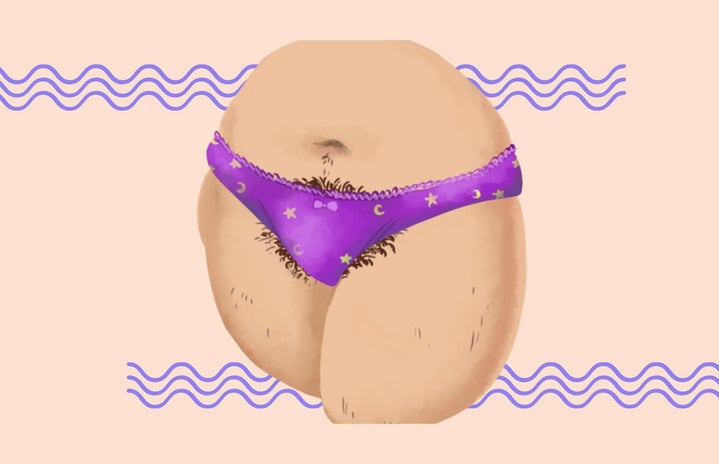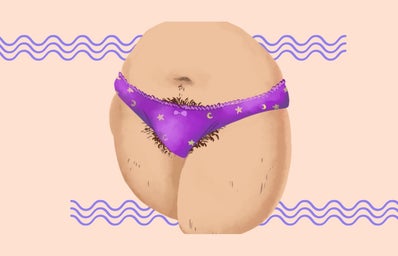The summer season is upon us, which means it’s time to bare (just about) everything, whether you’re hanging in your backyard pool or social-distancing at the beach. While it’s entirely possible to go too long without regular bikini area upkeep during the winter (hey, it’s entirely up to you whether you shave or not—and it’s okay if you don’t) it’s a different story during the summer. The more often you shave, the more likely you are to get ingrown hairs. As uncomfy as they are, it’s easy to keep them under control. Her Campus talked to board-certified dermatologist Dr. Jeff Donovan to get all the info.
What causes ingrown hairs?
Hair becomes ingrown when it grows sideways and curls back into the skin. “Even though they are harmless, they can result in tan or pink bumps and become infected,” explains Dr. Donovan. Translation? They aren’t pretty—Google at your own risk. The site of the ingrown hairs can also become painful.
“Shaving causes the tips of hairs to become sharp and may prevent hairs from properly exiting the skin,” says Dr. Donovan, but any type of hair removal can lead to ingrowns. Accordingly, ingrown hairs often appear on the underarms, legs, and bikini area in women and the face and neck in men. The coarser, thicker, or curlier your hair is, the more likely you are to develop ingrown hairs.
How can they be treated?
Scrubbing
One of the most effective ways of removing ingrown hairs—and preventing them from occurring in the future—is exfoliation. Use an exfoliating bar, like this one from Dove, or an exfoliating mitt, like this one. This method scrubs away the thin top layer of skin cells lingering on your skin’s surface, which traps hairs and causes them to become ingrown.
Toning
Toner is one of those overlooked products you might have hiding in your bathroom drawer. You probably used it to fight acne in high school (or now…ugh), but did you know it can soothe and treat ingrown hairs, too? Once a day, wipe your bikini area with a cotton ball dipped in toner that includes salicylic acid, like this one from Neutrogena. Skip this step in the day or two following a bikini wax – your skin will be extra-sensitive.
Remove the hairs yourself – gently!
You can also use warm compresses to soften the ingrown hairs, according to Dr. Donovan. Try this method to gently ease them out of your skin:
- Soak a clean washcloth in warm water.
- Press the washcloth against the ingrown area for three minutes to soften the hairs. This should bring the hairs to the surface of the skin.
- Using sterilized tweezers or a needle, gently work out the ingrown end of each hair one by one. Don’t pluck the hair out completely – just try to remove the embedded end.
- If you can’t easily treat a hair, don’t force it. Instead, soak your washcloth in warm water again and repeat the process.
- Wash the area with warm water and moisturizing soap, like this one from Dove.
While ingrown hairs can be frustrating to deal with, they probably aren’t serious enough to run straight to your dermatologist. That said, you should seek help if the area becomes painful or looks infected, especially if you removed the ingrown hairs yourself and created an open cut.
Can they be prevented?
If the thought of skipping hair removal forever to avoid ingrown hairs freaks you out, you’re not alone. Luckily, there are ways to reduce your chances of developing ingrown hairs while still maintaining smooth skin. Next time you shave, try this method:
- Use a wet washcloth to wash the area to be shaved for a few minutes with mild soap and warm water.
- Rub the washcloth in circular motions to help dislodge sharp tips of hair.
- Apply shaving cream and lather up.
- Shave in the direction of hair growth and avoid pressing down on the blade with too much pressure.
“If ingrown hairs continue to be problematic, I recommend using an electric razor or not shaving the area for an extended period of time,” says Dr. Donovan, as these methods are less likely to cause ingrown hairs. Waxing is also a safe option to consider.
Finally, laser hair removal and electrolysis are permanent solutions to hair removal. Although it’s a big commitment in both time and money, the benefits could be well worth it if you struggle with ingrown hairs – neither method of permanent hair removal causes them.

